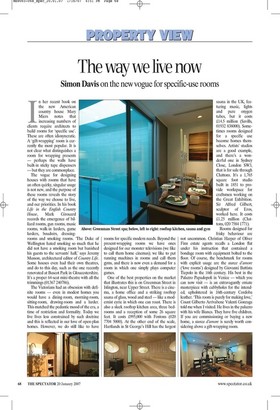The way we live now
Simon Davis on the new vogue for specific-use rooms 1 n her recent book on the new American country house Mary Miers notes that increasing numbers of clients require architects to build rooms for 'specific use'. These are often idiosyncratic. A 'gift-wrapping' room is currently the most popular. It is not clear what distinguishes a room for wrapping presents — perhaps the walls have built-in sticky tape dispensers — but they are commonplace.
The vogue for designing houses with rooms that have an often quirky, singular usage is not new, and the purpose of these rooms reveals the story of the way we choose to live, and our priorities. In his book Life in the English Country House, Mark Girouard records the emergence of billiard rooms, gun rooms, music rooms, walk-in larders, game larders, boudoirs, dressingrooms and smoking rooms. 'The Duke of Wellington hated smoking so much that he did not have a smoking room but banished his guests to the servants' hall,' says Jeremy Musson, architectural editor of Country Life. Some houses even had their own theatres, and do to this day, such as the one recently renovated at Buscot Park in Gloucestershire. It's a proper 64-seat mini-theatre with all the trimmings (01367 240786).
The Victorians had an obsession with definite rooms — even in modest homes you would have a dining-room, morning-room, sitting-room, drawing-room and a larder. This matched the pedantic mood of the era, a time of restriction and formality. Today we live lives less constrained by such doctrine and this is reflected in our love of open-plan homes. However, we do still like to have rooms for specific modern needs. Beyond the present-wrapping rooms we have ones designed for our monster televisions (we like to call them home cinemas); we like to put running machines in rooms and call them gyms, and there is now even a demand for a room in which one simply plays computer games.
One of the best properties on the market that illustrates this is on Greenman Street in Islington, near Upper Street. There is a cinema, a home office and a striking rooftop sauna of glass, wood and steel — like a modernist eyrie in which one can roast. There is also a sleek rooftop kitchen area, three bedrooms and a reception of some 26 square feet. It costs £995,000 with Foxtons (020 7704 5000). At the other end of the scale, Hartlands in St George's Hill has the largest sauna in the UK, featuring music, lights and pure oxygen tubes, but it costs £145 million (Savills, 01932 838000). Sometimes rooms designed for a specific use become homes themselves. Artists' studios are a good example, and there's a wonderful one in Sydney Close, London 5W3, that is for sale through Cluttons. It's a 1,765 square foot studio built in 1851 to provide workspace for craftsmen working on the Great Exhibition. Sir Alfred Gilbert, sculptor of Eros, worked here. It costs £1.25 million (Cluttons, 020 7584 1771).
Rooms designed for frisky behaviour are not uncommon. Christian Harper of Oliver Finn estate agents recalls a London flat under his instruction that contained a bondage room with equipment bolted to the floor. Of course, the benchmark for rooms with explicit usage are the stanze d'amore (love rooms') designed by Giovanni Battista Tiepolo in the 16th century. His best in the Palazzo Papadopoli in Venice — which you can now visit — is an extravagantly ornate masterpiece with cubbyholes for the intended, upholstered in 16th-century Cordoba leather. 'This room is purely for making love,' Count Gilberto Arrivabene Valenti Gonzaga told me when I visited. He lives in the palazzo with his wife Bianca. They have five children. If you are commissioning or buying a new home, a stanza d'amore is surely worth considering above a gift-wrapping room.





















































 Previous page
Previous page